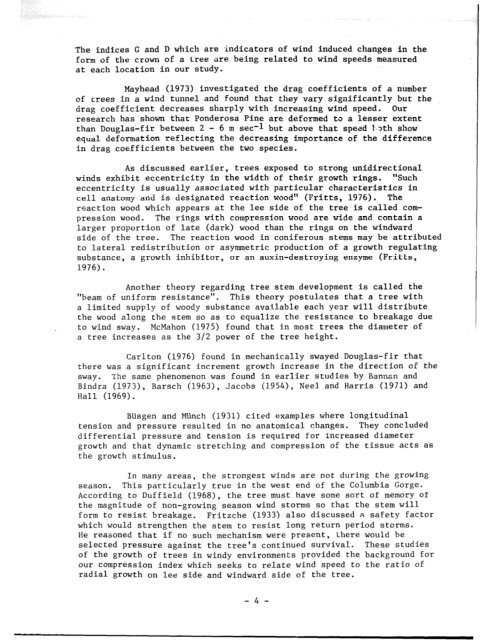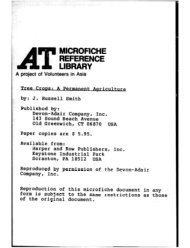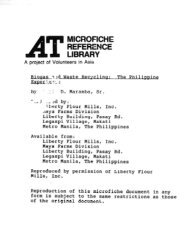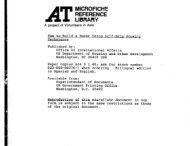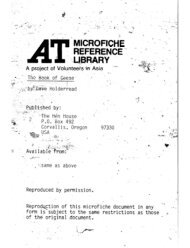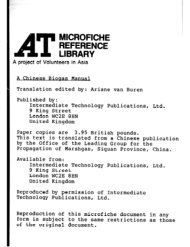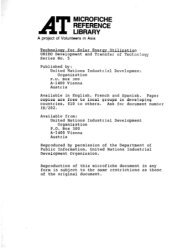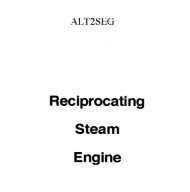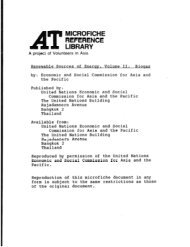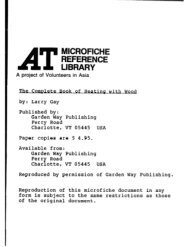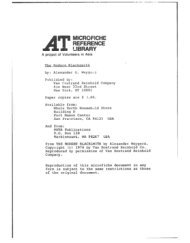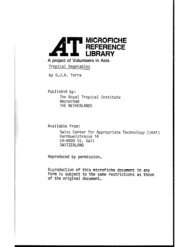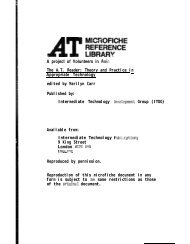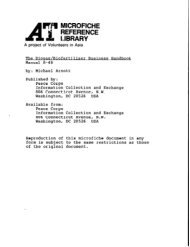Vegetation as an indicator of high wind velocity
Vegetation as an indicator of high wind velocity
Vegetation as an indicator of high wind velocity
Create successful ePaper yourself
Turn your PDF publications into a flip-book with our unique Google optimized e-Paper software.
The indices G <strong>an</strong>d D which are <strong>indicator</strong>s <strong>of</strong> <strong>wind</strong> induced ch<strong>an</strong>ges in the<br />
form <strong>of</strong> the crown <strong>of</strong> a tree are being related to <strong>wind</strong> speeds me<strong>as</strong>ured<br />
at each location in our study.<br />
Mayhead (1973) investigated the drag coefficients <strong>of</strong> a number<br />
<strong>of</strong> isrees in a <strong>wind</strong> tunnel <strong>an</strong>d found that they vary signific<strong>an</strong>tly but the<br />
drag coefficient decre<strong>as</strong>es sharply with incre<strong>as</strong>ing <strong>wind</strong> speed. Our<br />
research h<strong>as</strong> shown that Ponderosa Pine are deformed to a lesser extent<br />
th<strong>an</strong> Dougl<strong>as</strong>lfir between 2 - 6 m see-1 but above that spezd I,Dth show<br />
equal deformation reflecting the decre<strong>as</strong>ing import<strong>an</strong>ce <strong>of</strong> the difference<br />
in drag coefficients between the two species.<br />
As discussed earlier, trees exposed to strong unidirectional<br />
<strong>wind</strong>s exhibit eccentricity in the width <strong>of</strong> their growth rings. "Such<br />
eccentricity is usually <strong>as</strong>sociated with particular characteristics in<br />
cell <strong>an</strong>atomy <strong>an</strong>d is designated reaction wood" (Fritts, 1976). The<br />
reaction wood which appears at the lee side <strong>of</strong> the tree is called com-<br />
pression wood. The rings with compression wood are wide <strong>an</strong>d contain a<br />
larger proportion <strong>of</strong> late (dark) wood th<strong>an</strong> the rings on the <strong>wind</strong>ward<br />
side <strong>of</strong> the tree. The reaction wood in coniferous stems may be attributed<br />
to lateral redistribution or <strong>as</strong>ymmetric production <strong>of</strong> a growth regulating<br />
subst<strong>an</strong>ce, a growth inhibitor, or <strong>an</strong> auxin-destroying enzyme (Fritts,<br />
1976).<br />
Another theory regarding tree stem development is called the<br />
"beam <strong>of</strong> uniform resist<strong>an</strong>ce". This theory postulates that a tree with<br />
a limited supply <strong>of</strong> woody subst<strong>an</strong>ce available each yesr will distribute<br />
the wood along the stem so <strong>as</strong> to equalize the resist<strong>an</strong>ce to breakage due<br />
to <strong>wind</strong> sway. McMahon (1975) found that in most trees the diameter <strong>of</strong><br />
a tree incre<strong>as</strong>es <strong>as</strong> the 312 power OF the tree height.<br />
Carlton (1976) found in mech<strong>an</strong>ically swayed Dougl<strong>as</strong>-fir that<br />
there w<strong>as</strong> a signific<strong>an</strong>t increment growth incre<strong>as</strong>e in the direction <strong>of</strong> the<br />
sway. The same phenomenon w<strong>as</strong> found in earlier studies by B<strong>an</strong>nsn <strong>an</strong>d<br />
Bindra (1973), Barsch (1963), Jacobs (1954), Neel <strong>an</strong>d Harris (1971) <strong>an</strong>d<br />
Hall (1969).<br />
Biisgen <strong>an</strong>d Miinch (1931) cited examples where longitudinal<br />
tension <strong>an</strong>d pressure resulted in no <strong>an</strong>atomical ch<strong>an</strong>ges. They concluded<br />
differential pressure <strong>an</strong>d tension is required for incre<strong>as</strong>ed diameter<br />
growth <strong>an</strong>d that dynamic stretching <strong>an</strong>d compression <strong>of</strong> the tissue acts <strong>as</strong><br />
the growth stimulus.<br />
In m<strong>an</strong>y are<strong>as</strong>, the strongest <strong>wind</strong>s are not during the growing<br />
se<strong>as</strong>on. This particularly true in the west end <strong>of</strong> the Columbia Gorge.<br />
According to Duffield (1968), the tree must have some sort <strong>of</strong> memory <strong>of</strong><br />
the magnitude <strong>of</strong> non-growing se<strong>as</strong>on <strong>wind</strong> storms so that the stem will<br />
form to resist breakage. Fritzche (1933) also discussed a safety factor<br />
which would strengthen the stem to resist long return period storms.<br />
He re<strong>as</strong>oned that if no such mech<strong>an</strong>ism were present, there would be<br />
selected pressure against the tree's continued survival. These studies<br />
<strong>of</strong> the growth <strong>of</strong> trees in <strong>wind</strong>y environments provided the background for<br />
our compression index which seeks to relate <strong>wind</strong> speed to the ratio <strong>of</strong><br />
radial growth on lee side <strong>an</strong>d <strong>wind</strong>ward side <strong>of</strong> the tree.<br />
-4-


